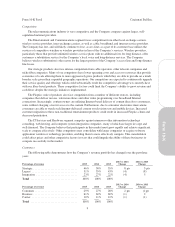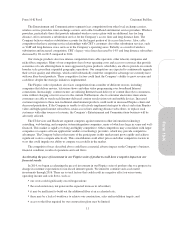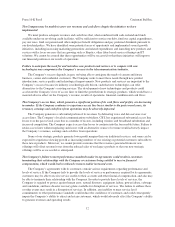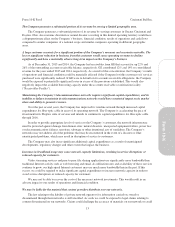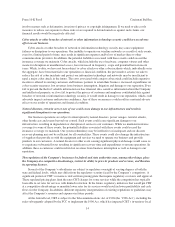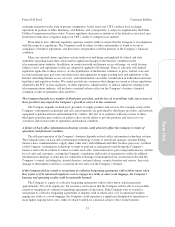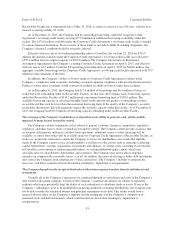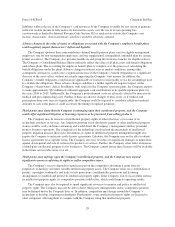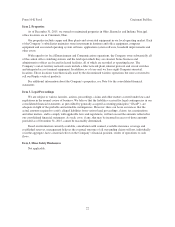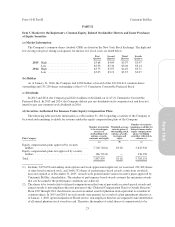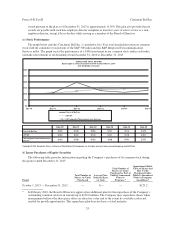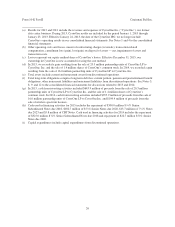Cincinnati Bell 2015 Annual Report Download - page 134
Download and view the complete annual report
Please find page 134 of the 2015 Cincinnati Bell annual report below. You can navigate through the pages in the report by either clicking on the pages listed below, or by using the keyword search tool below to find specific information within the annual report.Form 10-K Part I Cincinnati Bell Inc.
Receivables Facility has a termination date of May 30, 2018, is subject to renewal every 364 days, with the next
renewal occurring on May 30, 2016.
As of December 31, 2015, the Company had no outstanding borrowings under the Corporate Credit
Agreement’s revolving credit facility, leaving $175.0 million in additional borrowing availability under this
facility. The $175.0 million available under the Corporate Credit Agreement’s revolving credit facility is funded
by various financial institutions. If one or more of these banks is not able to fulfill its funding obligations, the
Company’s financial condition would be adversely affected.
Effective with our sale of 16.0 million partnership units to CyrusOne, Inc. on June 25, 2014 for $355.9
million, the amount available under the Corporate Credit Agreement’s revolving credit facility was reduced to
$150.0 million from its original capacity of $200.0 million. The Company entered into an Incremental
Assumption Agreement to the Company’s existing Corporate Credit Agreement on April 6, 2015, and effective
with our sale of 14.3 million CyrusOne LP operating partnership units on April 7, 2015 for $426.0 million, the
aggregate available borrowings on the Corporate Credit Agreement’s revolving credit facility increased to $175.0
million for the remainder of the term.
In addition, the Company’s ability to borrow under its Corporate Credit Agreement is subject to the
Company’s compliance with covenants, including covenants requiring compliance with specified financial ratios.
Failure to satisfy these covenants would constrain or prohibit its ability to borrow under these facilities.
As of December 31, 2015, the Company had $17.6 million of borrowings and $6.3 million of letters of
credit that were outstanding under its Receivables Facility. At that date, the Company had a borrowing capacity
under this Receivables Facility of $114.2 million and a maximum borrowing limit of $120.0 million. The
available borrowing capacity is calculated monthly based on the amount and quality of outstanding accounts
receivable and thus may be lower than the maximum borrowing limit. If the quality of the Company’s accounts
receivables deteriorates, this will negatively impact the available capacity under this facility. As of December 31,
2015, the Company had $90.3 million of borrowing capacity remaining under its Receivables Facility.
The servicing of the Company’s indebtedness is dependent on its ability to generate cash, which could be
impacted by many factors beyond its control.
The Company’s ability to generate cash is subject to general economic, financial, competitive, legislative,
regulatory, and other factors, many of which are beyond its control. The Company cannot provide assurance that
its business will generate sufficient cash flow from operations, additional sources of debt financing will be
available, or future borrowings will be available under its Corporate Credit Agreement or Receivables Facility, in
each case, in amounts sufficient to enable the Company to service its indebtedness or to fund other liquidity
needs. If the Company cannot service its indebtedness, it will have to take actions such as reducing or delaying
capital expenditures, strategic acquisitions, investments and alliances, or selling assets, including its investment
in CyrusOne, restructuring or refinancing indebtedness, or seeking additional equity capital, which may
adversely affect its shareholders, debt holders and customers. The Company may not be able to negotiate
remedies on commercially reasonable terms, or at all. In addition, the terms of existing or future debt instruments
may restrict the Company from adopting any of these alternatives. The Company’s inability to generate the
necessary cash flows could result in its dissolution, bankruptcy, liquidation or reorganization.
The Company depends on the receipt of dividends or other intercompany transfers from its subsidiaries and
investments.
Virtually all of the Company’s operations are conducted through its subsidiaries and most of the Company’s
debt is held at the parent company. Certain of the Company’s material subsidiaries are subject to regulatory
authority which may potentially limit the ability of such subsidiaries to distribute funds or assets. If any of the
Company’s subsidiaries were to be prohibited from paying dividends or making distributions, the Company may
not be able to make the scheduled interest and principal repayments on its debt. This failure would have a
material adverse effect on the Company’s liquidity and the trading price of the Company’s common stock,
preferred stock, and debt instruments, which could result in its dissolution, bankruptcy, liquidation or
reorganization.
18



